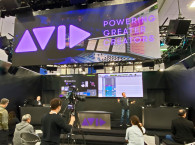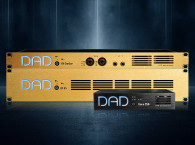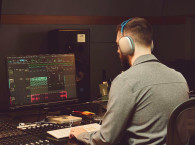
For the benefit of our many readers who don't normally follow the pro audio markets and are not exactly familiar with Avid and Pro Tools, enough to say that this is the market leading digital audio workstation (DAW) solution. Every year, almost all the records nominated for the Grammy Awards or the Academy Award Films are made using Pro Tools. In 2022, all Record of the Year Grammy winners and all movies nominated for Best Editing and Best Picture Oscars were mixed with Avid Pro Tools, and edited using Avid Media Composer.
Pro Tools was launched in 1991 and made a significant advancement in multitrack digital audio, creating the foundation for the hardware and software solutions that we call now digital audio workstations or DAWs - the center of every audio recording, mixing and post-production studio.
Avid Is Again Private
As I said, a lot is happening in the professional audio and the studio market, and that is reflected by recent events that have shaken Avid, the longstanding market leader in the segment. Just as I was writing this article for The Audio Voice, I received the news that industry veteran Jeff Rosica, who has been part of the leadership of Avid for more than a decade and CEO for nearly six years, just announced his retirement. I know Rosica for many years from my (and his) years in the broadcast industry (Grass Valley, Thomson...), and I have witnessed how instrumental he was in guiding Avid to recover from tough times.
The news comes days after the announcement that STG Symphony Technology Group, a private equity firm based in Menlo Park, CA, closed its acquisition of the company, which it bought for $1.4 billion in August, taking the company private again (now out of the NASDAQ).
Because of this momentous event in Avid's history, we have also learned more details about the company's financials and more importantly was the revelation that audio products still represent a very large percentage of the company's Creative Software Solutions revenues, with Pro Tools largely contributing to that. During recent trade shows it was clear that Avid is invested in maintaining growth in the segment. At the IBC 2023 tradeshow in Amsterdam (September 2023), Avid previewed some of the breakthrough technologies coming soon to Pro Tools.
Audio production professionals working in network television, streaming media and film are all mixing Dolby Atmos content and the vast majority are doing it in Pro Tools. And Avid is expanding its ongoing partnership with Dolby to support development and integration of the tools required for immersive sound. This includes Pro Tools with an integrated Dolby Atmos Renderer, allowing Pro Tools sessions to retain all mix data, ensuring users and facilities have compatibility across projects and seamless collaboration. Avid also previewed new development efforts to utilize Celemony ARA 2 technology to integrate iZotope’s RX Spectral Editor directly into Pro Tools. This enables a more fluid workflow to repair and clean-up audio using this leading software, almost an industry standard in dialogue editing.
On the hardware side, Pro Tools is still pretty much a world apart, with a large percentage of those commercial studios and post-production facilities (Pro Tools Ultimate users) depending on its HDX hardware accelerator PCIe cards, with its many DSP processing cores, large channel counts and low 0.7ms latency. These HDX PCIe cards connect to Pro Tools hardware over its dedicated DigiLink interface, and Pro Tools systems at the highest level will use up to three HDX PCIe cards to deal with large immersive audio projects.
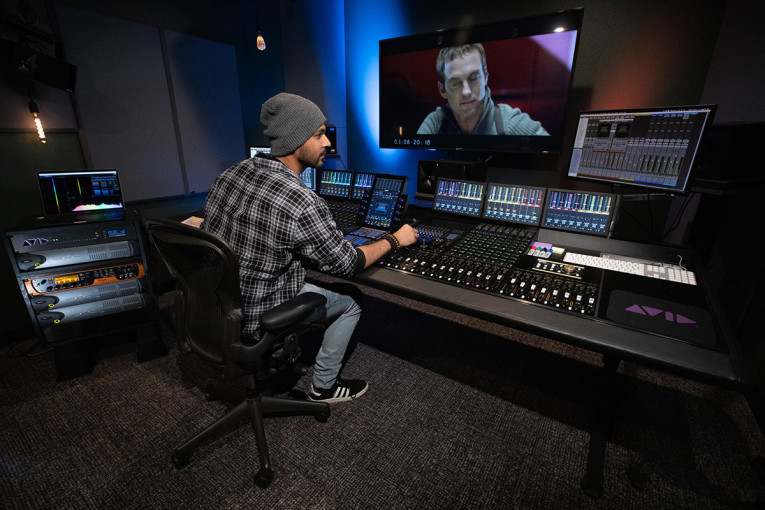
For most music production studios, the latest MTRX II audio interface, designed for Avid by Digital Audio Denmark (DAD - a business unit of NTP Technology) is now the ultimate solution. The MTRX II audio interface has opened up the possibilities for high-end audio environments, with its 256 channels of Dante and SPQ filters for room correction across a full 64-channel Theatrical Dolby Atmos monitor environment. MTRX II and MTRX Studio audio interfaces now also support Thunderbolt 3 connectivity with an optional Thunderbolt 3 card and allow users to interface directly to host computers running native Pro Tools, other DAWs or audio processors, while simultaneously connected to Pro Tools HDX over the dedicated Digilink port.
On the other extreme of the spectrum, where we find the musicians, bedroom studios, and laptop producers, Avid offers Pro Tools Intro (free), Pro Tools Artist, and Pro Tools Studio. This is an extremely competitive space where many other software companies lead in sales volumes (or free downloads) but are not necessarily leading in revenue, since those are generated precisely by the professional segments. And yet, the experienced team that is leading Pro Tools developments is well aware of the importance of "being the best" for everyone, even if not being the most popular option.
Among the most recent announcements - and a large focus for the AES NY presentations on the Avid booth - is Pro Tools Sketch, a new expansion for music creators that is effectively a "late but much needed" answer to the popular Ableton Live software. Sketch is a clip-based creation tool that enables musicians to quickly capture new ideas and experiment with arrangements (something that Logic, Cubase and all the other leading DAWs also offer).

From Digidesign to Avid
Born and educated in France, François Quereuil worked with Digidesign, a division of Avid for nearly 9 years, from 1999 to 2007. He left Avid to work at Aspera (IBM) for more than 10 years, where he was the Senior Director, Worldwide Marketing. From that world of file transfer and streaming software, he returned to Avid as director of Product Management, Pro Tools & Control in 2018. Based in San Francisco, he now leads the whole Audio Product Management strategy at Avid.
Ed Gray, a Digidesign Pro Tools pioneer, who worked with François since his early Digidesign days and still works at Avid today, says the following of François Quereuil: "Digidesign has succeeded based on two strengths, the technical power of our products and our skill in boasting about these products to the world. François is the intelligence, energy, clarity and leadership that drives the latter."
I was happy to interview François Quereuil at the AES NY convention this year, remembering well the days when we used to meet at the Digidesign press events - as I promptly reminded him. He was one of the leading forces of Digidesign's marketing, following the acquisition by Avid in 1995 - together with Dave Lebolt, Digidesign general manager and technical leadership that led to its expansion - and when the company acquired M-Audio, Peter Gorges' Wizoo, and Sibelius. Like Lebolt, François left before Avid decided to kill the Digidesign brand in 2010.
J. Martins: A lot has happened with Pro Tools in 32 years, and Pro Tools remains an essential part of Avid's business. I have the feeling that now Pro Tools is now even more a priority for Avid, correct?
François Quereuil: It's a priority. A few years ago we reorganized ourselves in a business unit structure within Avid - the audio business unit, and a video business unit. We have some shared services like sales, HR, finance, marketing, et cetera. But now we've been able to refocus on the audio business. "How much do we spend to make stuff"? "What are the resources that are focused on audio?" And "what is the sort of output and the result?" We've done this during the pandemic.
Audio and video are almost evenly matched in terms of their contributions to Avid's overall revenue. And as you can imagine, Pro Tools is the largest part of audio. We now cater to a lot of different audiences, which is the biggest challenge that I have, which means trying to maintain a platform that has extremely high-end professionals that rely on Pro Tools. They need it to be reliable. They're operating in mission-critical environments. They're also using our consoles, our hardware, our software, and it all needs to work day in and day out.
And then on the other end of the spectrum, you have bedroom producers, beginners that want to be part of this world. And in the middle, we also have a lot of folks who are a little bit more serious about production, or freelance people that work either in music or in post-production. So the spectrum of our audience is complex, which is why we also had to reorganize ourselves and our development capabilities so that we can bring something to everybody on a regular basis.
In September we launched Sketch. Obviously that's aimed for the music creation side of the market. I think we did a pretty good job with the app and the new window in Pro Tools... And by the way, that's just the beginning. We're doing a lot more. It's going to keep evolving as we go. And now I'm looking forward to the next release of Pro Tools that will happen by the end of 2023. Now this is way more pro-focused. We're taking the Dolby Atmos renderer and we'll fully integrate that into the Pro Tools environment. So you won't need to use a separate application and that really streamlines the workflow.
We're working very closely with Dolby on that project.
We're also working with iZotope on integrated RX Spectral Editor inside of Pro Tools with ARA. These are some of the things that we're focused on and we've got a lot of great feedback from users.
We're still very committed to all aspects and all audiences of Pro Tools. I think our users are starting to understand that we are delivering meaningful updates, and updates every three months, which is just a tall order. It's a lot of work for a lot of people.

JM: From Intro to Ultimate that is a lot of range for Pro Tools to cover. Are you able to update all those versions at that pace?
FQ: Now it is unified. We used to have different code branches. Now we've unified the binary for Pro Tools. So depending on what you bought you get the functionality, but your installation of Pro Tools is basically one. So even, for example, some of our subscribers can decide one day, "oh, I don't want to pay for this anymore." And automatically Pro Tools will become Pro Tools Intro. So you can still do some stuff for free.
JM: Don't you feel that these updates, and regular upgrades and bug fixes have killed the excitement - and consequently the promotional effect that was associated with major software releases every year or so? Shouldn't the subscription model still be linked to major versions and not only upgrades and bug fixes making it more rewarding for users?
FQ: Absolutely. What's interesting about that is that we spend a lot of time with every release, really fixing things. And I think even our most professional users - the ones that would go, "I'm not going to try the new version for another six months because I want things to be fixed beforehand," are starting to update their software faster, because they've noticed our software is really getting more stable with every release. Now, obviously for mission critical environments, they take their time, they don't necessarily do it on the day of release, but for things such as the internal Dolby Renderer, for example, everybody's gonna want that pretty quick.
JM: Yes, that's interesting, because now we have laptop producers mixing Dolby Atmos tracks.
FQ: It's great too, because everybody's listening to spatial audio on their devices now. And I think - for me and for the industry - it's really interesting that Atmos has become such an important format. And there are others, by the way, that I think are as interesting, such as MPEG-H and 360 Reality Audio.
What's really interesting to me is giving folks a new experience of music that is actually rewarding, that you don't have to have special gear for. You can just do it on headphones or you have a Sonos at home or whatever. But what's interesting right now is not just remixing old catalog and old music. It's thinking about - as artists - how do I use this space right from the get-go and have a mentality of doing things in immersive? So there's an approach as a musician or as an artist or a producer. And then there are all the tools that are coming in... like now there are immersive synthesizers, you know? And to me, that's super exciting. It's a lot of possibilities.
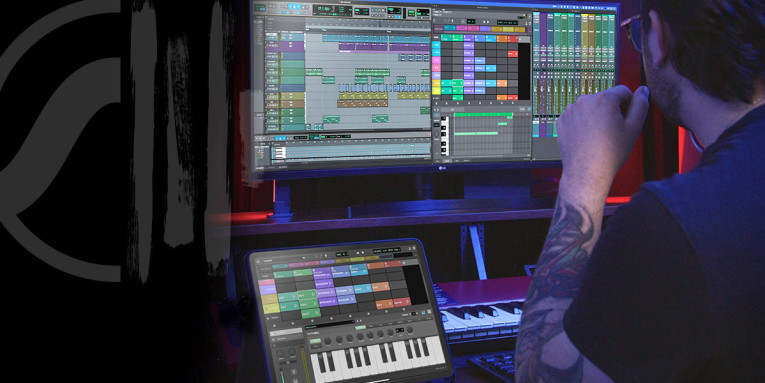
JM: As the production needs are changing, we can also witness the increasing use of the cloud. Avid has invested heavily in the cloud for the video products, which need to transfer much bigger files, but it seems not so much for the audio products. Why is that?
FQ: It's interesting, because the technical challenges for audio are actually much greater than for video. Yes, the video files are bigger, but it's not like you're mixing 700 signals together, right? So there's a number of streams, and that's much harder to move over the Internet. It's harder to move a lot of smaller files than one big file.
Then there's the idea of running your software in the cloud, and there's the monitoring aspect, the latency, et cetera...
There's a need for collaboration? Absolutely. During the pandemic, people kind of started figuring it out. But what people have been using during the pandemic was kind of putting different technologies together. They kind of figured it out how to make things work... or send something. But it's still complicated.
I see now that it's accepted. Even the big content companies, even the big studios, now are willing to have their content available for people to do work remotely. So the security is very important.
I find this space really, really interesting. There's massive amounts of opportunity for things like doing "review and approval." When you have an Atmos mix that you need a whole bunch of different people to listen to, and you can't put them all in the same room. Why don't you give them all the same pair of headphones and everybody's listening binaural? You can do that now.
Remote recording is becoming a reality. You know, a band playing together is probably still difficult because you have the laws of physics... So there's always latency, by default. But doing a remote ADR session, when an actor cannot travel, or do a voice over, or a foreign language dubbing...
For us, we'll probably always need some sort of software piece locally. Can data exist in the cloud and be streamed? I think so. In our world, I would say that it's more of a proxy situation where some of this stuff might be moving alive via the Internet, but there's going to be a lot of "caching" happening on your local systems just to make sure that you have the best possible experience locally.
We're looking at all that very closely right now.
There's a lot of really interesting technologies in the market space right now. And obviously, we already have cloud solutions on the video side of the business, where we do a lot in the cloud. So we have a lot of expertise. It's pretty exciting for us and it's definitely in our strategy to tackle collaboration between musicians, audio engineers...
And by the way, in the context of interoperability between our audio tools and our video tools. We're doing a lot to make those work better together. The goal is to get to a point where video people and audio people can work on the same media at the same time, obviously without killing each other's work. But in real time. To be more productive and wherever they might be located. That's the holy grail of collaboration where it's real time concurrent collaboration!
Also because we see this in the content industries. It used to be simple. The filmmaker would finish the film. Give the audio guys the final cut. And then you do the audio. Now... they make picture changes until like a week before release. So the back and forth is immense. There's a lot of time being wasted.

JM: Okay, let's talk about hardware. Avid used to manufacture real nice hardware and it always was considered a reference in the recording business to have the "official" hardware for Pro Tools. How do you see the integration between software and hardware evolving? Officially, you are using DAD interfaces...
FQ: So hardware-wise, I think we have areas of real expertise as Avid. Our real expertise - the fundamental thing that we're really, really, really good at - is the integration of the software component, Pro Tools, with a really rock solid audio core platform. In this case it is still HDX.
I know it's not new, and it's been around for a long time, but it still does things better than anybody else! There is virtually no latency. It's extremely reliable. It is scalable. And now with some of the software advances that we've brought to market over the past few years, you can run it hybrid. So you can run the DSP where you want it, and then leverage the power of today's modern computing platforms like the new Macs and have basically the best possible, most capable system possible.
On the I/O side, we started a partnership with DAD a few years ago. We created something of a standard, because the system is amazing. First of all, it sounds great. And the card capability of being able to customize your routing, and all the built-in routing matrix of the MTRX, is really significant.
We did an update to MTRX recently with MTRX II, which is more capable, but fundamentally is kind of the same thing.
We're introducing Thunderbolt capability because we know that HDX is still required for high-end workflows. It's still required for frame accurate synchronization with picture. But for many workflows, it's not necessarily needed. So we now have a Thunderbolt card that runs in MTRX and MTRX Studio, and you can run those systems natively. Can you run hardware from another company as well? Absolutely. And we're not shying away from that at all.
I think getting the users' choices is really important.
Another really huge part of our expertise is the control surfaces. So you look at S6 and also on the lower end of the S1 and the Dock, we have the best protocol to control a DAW that exists. EuCon is the most efficient, fastest, highest performing way of controlling not only Pro Tools, but any DAW. It's Cubase, it's Nuendo, it's Reaper, it's Adobe Premiere...
That's where we shine because we really have a level of depth of control of the environments that is so much better than everyone else's. And even just in the simple things as the resolution of the faders.
JM: Avid acquired Euphonix, and that's where EuCon comes from. But why then couldn't you continue to make more hardware, apart from the control surfaces?
FQ: Yeah. Well, we saw an opportunity to do something with technology that we didn't have. And we thought it was really important, with the growing need for mixing in Atmos which was starting at that time. We were the first ones to the party when it comes to Atmos. And Dolby Atmos studios needed way more I/O that we were able to provide. And they needed very complex routing matrix of all the new speakers, et cetera. So instead of developing it, we saw a good synergy with DAD to actually use their product.
That relationship is going great. We have a standard in the market. There's matrixes everywhere. Actually, because of supply chain disruption, because of COVID, we couldn't deliver for a while. And people did not buy anything else. And now we've cleared all of our backlog and there was no migration to any sort of other solution because that's exactly the solution everyone needed.
Where we're going in the future with hardware? We are not going to disengage from hardware. I think we still need to do the control surfaces. We need to take those, and the functionality of EuCon, to the next level. We still need to do for the future a new core platform of some kind. Right now we are using old DSP technology. There's a lot of new technologies and we're looking at a lot of options right now of where we can take that.
And we've done also a bunch of lower end devices. So we have the Carbon...
JM: ...let's just say that the AVB technology choice on Carbon was not exactly the smartest decision...
FQ: I don't disagree. I think the reason for that was the fact that we have really great command over AVB, because we've done it for our live sound system, and at that time we wanted to get a product out...
We really wanted to get a product out in Thunderbolt, but that proved to be really, really complicated. It would have made more sense. Absolutely. It would be a much bigger success than it is. I think as a product though, I have the Carbon in my studio and it doesn't just work. It is one of the best sounding music interfaces available today. It sounds amazing. The preamps are amazing. And now that at least we have the expansion capability with the Carbon Pre, you can create a much larger system, which has been really successful. But... I do agree. AVB was not the best choice.

JM: My final question would be about the Dolby Atmos momentum and the challenge of binaural rendering. Do you believe that a deeper integration in Pro Tools will help to mix more reliably in Dolby Atmos?
FQ: If you think about the content industry, picture, television... 90% of it is done on Pro Tools. And people have very specific workflows that are working very well for them.
Really, the internal renderer came from a request from our customers. Mostly because they wanted to have simpler, more cost-effective workflows. Netflix, for example, has a lot of content that's being done all over the world. And in some cases, they don't have the resources of a Hollywood studio. And the idea of being able to combine those things and make it more affordable was a big deal.
For music, it's just about making it as simple as possible. So one of the things we're going to work on for the internal renderer is there'll be a really full, deep complex version of the renderer that folks that do Atmos today in big studios will be happy with. And we're also working on an easy button for Atmos. We don't know if those things are going to come out at the same time because it's a little bit more work.
It will be an easy way to simplify routing, and make it more accessible for folks that either are new to mixing in immersive formats, or that don't need the level of depth that the other guys do. So that's a really important part of the strategy is to democratize immersive production.
When I say Atmos, we're very actively thinking about other formats as well. We'd like to be seen as the platform to do any sort of immersive sound. We support Ambisonics. We did a collaboration with Fraunhofer on offering their MPEG-H authoring tools with Pro Tools. We're working with Sony on 360 RA. So there will be all of these things - at some point being fully integrated part of the Pro Tools environment.
We also did all the things that we needed to do from an architecture standpoint, such as supporting much bigger track widths, and more track widths so that then you have tools and plugins and instruments that can actually leverage the full spectrum of multichannel audio.
JM: Are you already implementing MIDI 2.0?
FQ: We are doing a lot of work on the MIDI side of things. We are not supporting the MIDI 2.0 spec yet. Believe it or not, we were not part of the MIDI association, so we fixed that and we're actively participating.
We have a team dedicated to MIDI, and you'll see a lot of that into the next year because we've turned our attention to the MIDI part of Pro Tools and did some exciting things. We'll talk a lot about this at NAMM 2024.
I mean, I'm a musician, so this is really important to me. aX
This article was written and published original for The Audio Voice newsletter 446, November 16, 2025.




